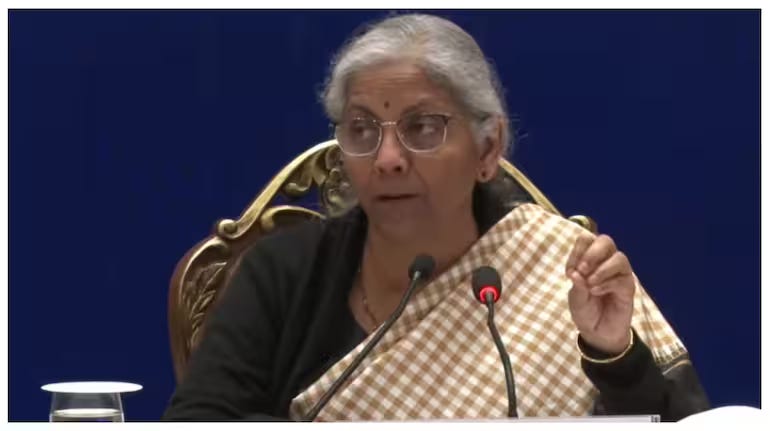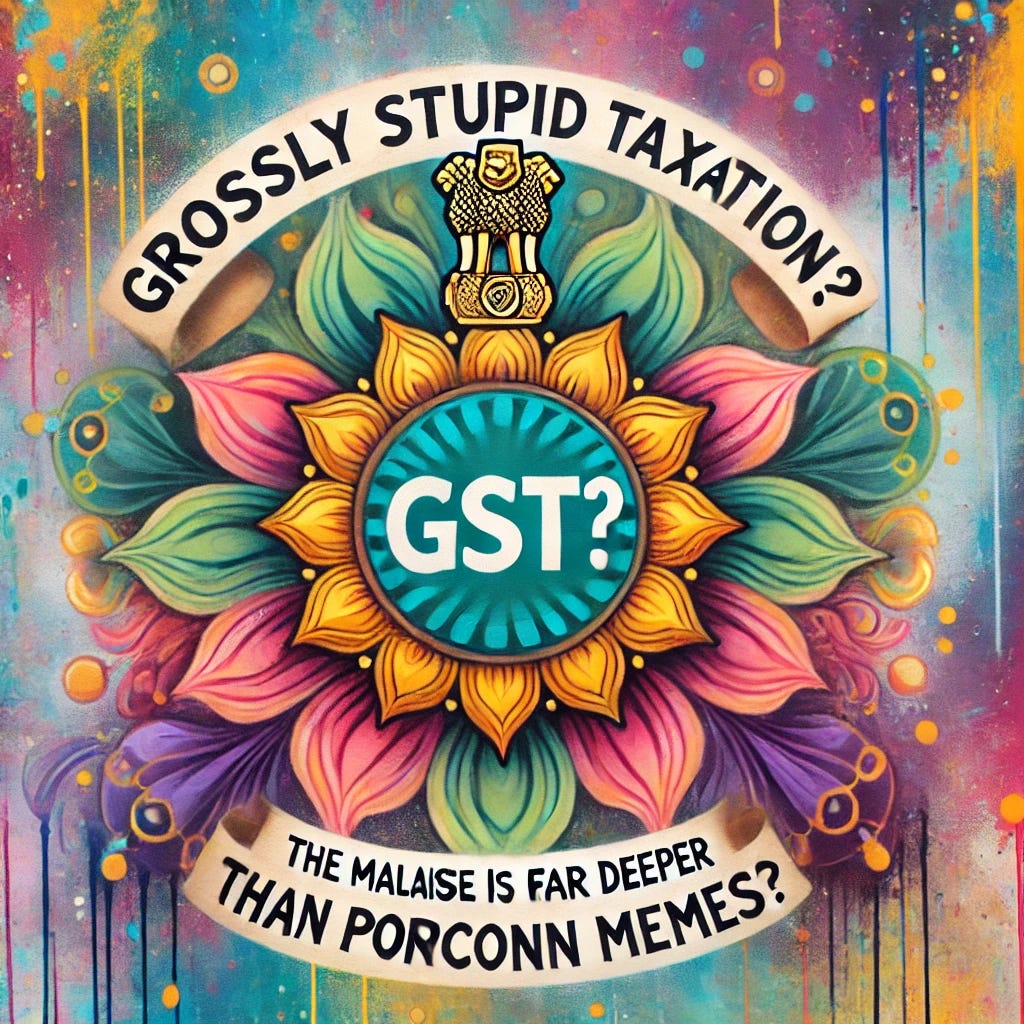Grossly Stupid Taxation (GST)? The Malaise is Far Deeper than Popcorn Memes
Infosys, that designed and implemented the flawed GST Network—whose Chairman touts 70-hour work week—deserves our strident criticism.
Popcorn Taxation and the Complexity of GST
The Goods and Services Tax (GST), once celebrated as a revolutionary step toward simplifying India’s tax regime, has often exposed its own layers of complexity. A recent controversy surrounding the taxation of popcorn—ranging from 5% on unpackaged, 12% on pre-packaged, to 18% on caramelized varieties—has become a talking point, spawning memes and public debates. The Finance Minister's video clarification and the promise of a circular for further guidance have done little to mask the underlying intricacies. This incident underscores the broader challenge of reconciling the ideal of a streamlined tax system with the diverse realities of India's trade, commerce and economy.
Expert Criticism: From "Good and Simple" to "Grotesque and Trivialized"
The popcorn taxation saga has reignited criticism from leading economists over the deeper flaws in GST's design and implementation. Arvind Subramanian, former Chief Economic Advisor, expressed his dismay, labeling the situation a "national tragedy" and lamenting how the GST has deviated from its original promise of being a "Good and Simple Tax." Instead of progressing toward simplicity, he argued, the system has veered into greater complexity, irrational enforcement challenges, and inefficiency. Echoing this sentiment, Rathin Roy, a distinguished economist and former Director of the National Institute of Public Finance and Policy, called the GST a "comic travesty" and a "Grotesque and Trivialized Tax," blaming clumsy design, administrative ineptitude, and poor political oversight for its current state. Their critiques highlight a growing consensus that GST, in its current form, has fallen woefully short of the promise of "One Nation, One Tax," the very leitmotif of this ambitious tax reform and its transformational aspirations.
Systemic Flaws: The Persistent Software Challenges in GST
In response, we tweeted to highlight a critical concern: despite having no legacy issues, the GST software and system design remain riddled with glaring loopholes that not only allow but seem to facilitate large-scale tax frauds through fictitious input tax credits. These persistent weaknesses raise serious questions about the system’s implementation, particularly given the involvement of reputed firms like Infosys.
This concern goes beyond mere technological glitches; it strikes at the heart of GST’s credibility as a streamlined and efficient tax regime. For traders and manufacturers, these flaws translate into increased compliance burdens and financial risks. For bureaucrats, they exacerbate enforcement challenges, while for economists, journalists, and policymakers, they reveal the growing disconnect between GST's transformative promise and its underwhelming delivery. A comprehensive approach is needed to address these systemic issues, starting with a deeper alignment of technology, policy, and operational execution.
The Financial Impact of GST Systemic Loopholes
The systemic flaws within the GST framework have had staggering financial implications, as evidenced by recent data on tax frauds uncovered by the Directorate General of GST Intelligence (DGGI). In FY24 alone, GST evasion reached an unprecedented Rs 2.01 lakh crore, nearly doubling from Rs 1.01 lakh crore in FY23. A significant portion of this evasion stemmed from specific sectors such as online gaming and casinos, which accounted for Rs 81,875 crore, followed by Rs 18,961 crore from the BFSI sector, and Rs 16,806 crore from iron, copper, and scrap industries.
One of the most alarming issues is Input Tax Credit (ITC) fraud. Over Rs 35,132 crore worth of ITC evasion was linked to 17,818 fake firms, with 2,197 cases detected amounting to Rs 21,089 crore in FY24 alone. Despite enhanced recovery efforts, only Rs 26,605 crore was recovered during FY24, reflecting the scale of the challenge. The recovery rate for ITC fraud cases, though improved to over 12%, remains far below acceptable levels.
The implications extend beyond financial losses. Approximately 18,000 fake companies were identified, involved in Rs 25,000 crore worth of tax evasion, while 113 masterminds of ITC fraud were arrested. These fraudulent schemes often exploit unsuspecting individuals for KYC documents, create fake invoices, and employ sophisticated methods such as clandestine supply chains and undervaluation.
The persistence of such loopholes underscores the urgent need for systemic reform and advanced technological integration. While the DGGI has employed data analytics and AI tools to improve detection and recovery, the figures highlight the magnitude of tax evasion facilitated by the GST system’s vulnerabilities. Without addressing these core issues, the promise of GST as a streamlined, efficient tax regime will remain unfulfilled.
Loopholes in GST Implementation: A Refined Overview
The implementation of GST in India has exposed several critical flaws and vulnerabilities that have facilitated large-scale tax frauds and fictitious input tax credit (ITC) claims. Below is a breakdown of the key issues:
a.) Input Tax Credit (ITC) Exploitation
One of the most significant weaknesses lies in the GST Network's inability to effectively link supplies across the value chain. This gap enables buyers to claim ITC without actually receiving supplies from fraudulent suppliers. For instance:
Firms issue invoices without supplying goods or paying tax, while others claim ITC based on these false invoices[5].
The prevalence of fake invoicing has made it a common tool for claiming undue ITC or reducing tax liability[2].
b.) Registration Vulnerabilities
The GST registration process remains a critical point of exploitation:
Minimal validation during the online registration process facilitates the creation of fake companies[3].
Fraudsters use forged documents, such as electricity bills and rent agreements, to obtain GST registration[5].
The exemption for businesses with annual turnover below ₹20 lakhs is exploited by splitting larger businesses into smaller entities to evade taxes[6].
c.) Compliance and Verification Challenges
Complex compliance requirements, including filing 49 returns annually for a single business, create opportunities for errors and fraudulent activities[6].
Inadequate physical verification of registered businesses allows non-existent firms to operate undetected[5].
Systemic Shortcomings
a.) Technological Gaps
The heavy reliance on online submissions is hampered by inadequate infrastructure, leading to frequent crashes and delays[6].
There is a lack of real-time data sharing and analytical capabilities across tax authorities[3].
b.) Inter-State Enforcement Complexity
The diversity of languages, cultures, and administrative systems across states complicates GST enforcement and makes it challenging to track fraudsters operating in multiple regions[10].
c.) Delayed Detection
Fraudulent companies often operate for up to six months before detection. By the time they are identified, they frequently disappear, making recovery efforts futile[10].
Sophisticated Fraud Techniques
a.) Circular Trading
Fraudsters engage in circular trading by artificially inflating turnover through multiple firms to claim fraudulent refunds[2].
b.) Identity Theft
Stolen identities are used to establish fake companies and bank accounts, making it difficult to trace the real perpetrators[1].
c.) Misclassification of Goods
Deliberate misclassification of goods is employed to claim refunds on exports that are not eligible for such benefits[2].
Conclusion: From Popcorn Memes to a Systemic Malaise
The memes generated by the popcorn taxation saga may have amused the public, but they are a symptom of a far deeper malaise within the GST framework. Leading economists have criticized the system for its clumsy design, administrative ineptitude, and increasing complexity, which has strayed far from the original vision of a “Good and Simple Tax.” This criticism is accentuated by the humongous frauds that have come to light, with over Rs 2.01 lakh crore in GST evasion detected in FY24 alone. Our biting critique of Infosys—whose nearing octogenarian Chairman offers 70-hour work week advice while the company created a system teetering on gross incompetence, if not criminal negligence—points to the urgent need for accountability and reform.
The loopholes and vulnerabilities within the GST framework have fostered a sophisticated ecosystem of tax evasion, involving fake invoices, phantom firms, and fraudulent ITC claims. Although the government has introduced measures like data analytics and biometric verification, these initiatives barely scratch the surface of the structural flaws. The system’s complexity continues to burden traders, manufacturers, and enforcement agencies alike, undermining its credibility and efficacy.
To tackle these challenges, comprehensive reforms are imperative. Establishing a streamlined and robust technological infrastructure, reinforced by advanced enforcement mechanisms such as AI, is critical to restoring confidence in the GST regime. Decisive action and accountability are the only paths to realizing GST's potential as a truly transformative economic reform. However, whether Infosys's broken system is capable of delivering this transformation remains highly doubtful.







